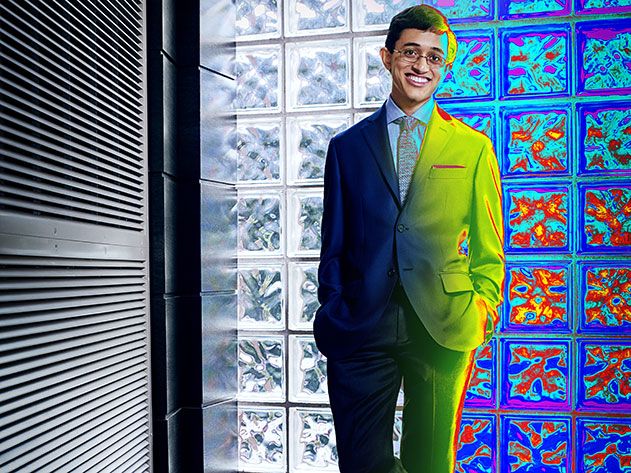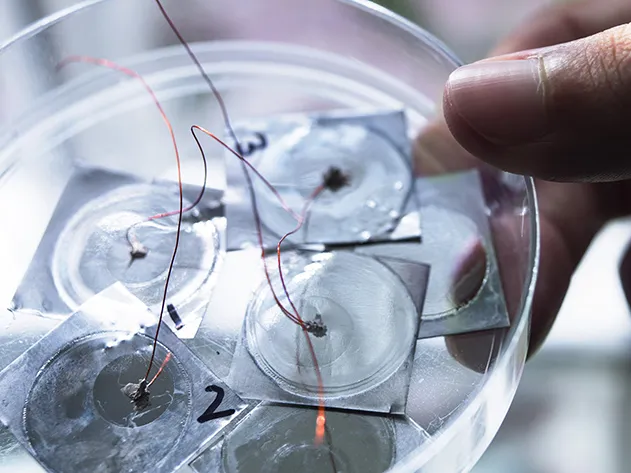The Freshman at MIT Who is Revolutionizing Nanotechnology
Teenager Saumil Bandyopadhyay has harnessed cutting-edge physics to upend industries ranging from automobiles to astronomy
/https://tf-cmsv2-smithsonianmag-media.s3.amazonaws.com/filer/Saumil-ingenuity-portrait-631.jpg)
At the age of 18, Saumil Bandyopadhyay had five peer-reviewed scientific papers to his name, but no driver’s license. His busy schedule was partially to blame—he spent much of high school in an electrical engineering lab at Virginia Commonwealth University, wearing a hairnet and tinkering with nanowires. Since his dad was a professor there, he always had a ride home.
But in truth, driving terrified him. He winced at the mere mention of a merge. “The collision possibility is very real,” he says one day at home in Glen Allen, Virginia. He’d started learning on his mom’s Honda Civic, but soon dropped the notion.
Instead, he worked even harder on the magnum opus of his young career: a unique infrared detector, which may one day reduce car crash rates by allowing vehicles to sense each other in fog or darkness. The nanoscale contraption, which to the uneducated eye looks like a silver postage stamp, might also someday help spy on stellar nurseries, detect hidden land mines and monitor global warming. Most exciting, it operates at room temperature, without the cumbersome and expensive tanks of liquid nitrogen needed to cool most other infrared sensors.
“It’s a breakthrough—a different way of measuring infrared,” says Gary Tepper, a VCU professor who tutored Bandyopadhyay on one aspect of the project. “We have high-school students in the lab all the time, but we don’t usually see doctoral-level research.” When John Mather, the Nobel laureate astrophysicist, noticed the infrared device at an Intel Science Fair, he invited Bandyopadhyay to NASA’s Goddard Space Flight Center to discuss it. “I thought it was an ingenious idea,” Mather says. “He’s a brilliant kid.” The device has also attracted the interest of the U.S. Army.
Saumil’s youth, to be sure, was rarely typical. “He developed in fits and starts,” said his father, Supriyo, a professor of electrical and computer engineering. Saumil could add by age 2, but he didn’t speak until 3 1/2. Then he went from mute to fluent, chatting away in the Bengali his parents spoke at home. At the start of kindergarten, he knew just a few phrases in English, such as “call Mommy.” Yet barely a year later he was spouting off ten pages of narration for the first-grade play. “I was the only one who could read it,” Saumil says.
What the family calls Saumil’s “professional” career began in seventh grade, when he worked on a science fair project with one of Supriyo’s university colleagues. “The experiment didn’t do very well,” Supriyo says, “but nonetheless, he won.”
Over the years Saumil would rack up countless other prizes, including tens of thousands of dollars in science fair scholarship money. The lava lamp in his boyhood bedroom is a prize (courtesy of the Google Science Fair), as is the baseball cap and the calculator and the clock. Even the stuffed bunny is a prize, for the highest grade in middle-school English.
Glory has a price, of course. Saumil can be so focused on the task at hand that he forgets to eat—at the International Space Olympics in 2011, he dropped eight pounds off his already slender frame. But his mother, Anu, objects to the adjective “studious.” “He likes to do other things more than reading schoolbooks,” she says. “He likes his Quizbowl. He would study two hours at least every day when he was trying to get onto the A-team. Every day! At least two. So we don’t exactly know when he goes to bed.”
“It’s rare that I am up past 2 a.m.,” he reassures her, though he sometimes doesn’t go to sleep at all.
At first his parents saw the high- school Quizbowl team as a threat to Saumil’s real work, but he proved that he could maintain his grades. He also indulges a weakness for Bollywood action movies, which he watches with his mom, nibbling a crunchy Indian snack called dalmut, and for all things Harry Potter: The seven volumes of the boy wizard’s adventures went with Saumil to college this fall, along with a text that might be considered his own book of spells, Quantum Mechanics.
***
The energy that the infrared detectors gather is all around us: With long wavelengths of light invisible to the naked eye, infrared radiation is emitted by everything from trees to Honda Civic engines to human bodies to dying stars.
But the detectors themselves are finicky gizmos whose readings are easily confused. They work when a photon of light strikes a semiconductor material, knocking an electron loose and creating a measurable electrical current. Because of their long wavelengths, though, infrared photons have very small energies; in an infrared photodetector, the semiconductor materials have very loosely bound electrons so a weak infrared photon can boot one out of orbit.
Therein lies the challenge. “When you get to energies that small, there are other things besides light that can also kick electrons out of the atom,” Saumil says. Like heat generated by the device itself. This phenomenon, known as thermal shaking, can muddle the readings of an instrument such as an infrared telescope. To counteract that effect, liquid nitrogen is often used to cool the entire device so that only infrared radiation emanating from the desired source is measured—a delicate, expensive undertaking.
Saumil’s approach has been to abandon the realm of classical physics entirely. His infrared photodetector is made of nanowires, each of which is about one ten-thousandth the width of a human hair. “Because we’re dealing with such small structures, this weird physics takes over so that it’s selective and only detects a small window of light frequencies. Plus, only photons of infrared light can knock out electrons, not thermal shaking,” he says. “That’s a quantum mechanical effect.”
To explain what they mean, Saumil and Supriyo take me to what’s called the “clean room” at VCU. We zip on bodysuits and don hairnets and booties to protect the delicate nanostructures being fabricated nearby. Saumil leads me to his workbench, where beakers of jade- and ruby-colored liquids await.
He screws a one-inch square of aluminum foil to the outside of a beaker, fills it with sulfuric acid, connects wires and then passes a current through the foil. This creates an oxide film on the aluminum that (though we’d need a high-powered microscope to see it) looks a lot like a honeycomb. Then into the same beaker Saumil pours solutions containing cadmium and sulfur, and zaps the thing again. The semiconductor material fills in the pores in the honeycomb, which works like a stencil.
The result is an array of nanowires with unique absorption properties. As the two materials bond, some atoms stretch and others compress, creating defect sites called electron traps. The only thing that can free an electron from its trap is a photon of infrared light.
The photodetector is small enough that Supriyo keeps a little dish of them on his office desk, like candy. He says they are cheap to manufacture, easily mass-produced and difficult to break, which makes them a potential tool for monitoring infrared radiation on a worldwide scale. Saumil imagines scattering them around the polar ice caps to study global warming. (Astronomical applications, though intriguing, seem unlikely in the near term; infrared telescopes are such high-stakes instruments that scientists will continue to cool them with liquid nitrogen.) Saumil’s infrared detector is also very sensitive. By switching semiconductor materials and using ultra-small structures, he’s able to tailor it to pick up on a specific frequency of infrared light, instead of all infrared light, a feature that caught the Army’s eye. For the last two summers, Saumil has worked with an Army lab, through the Student Temporary Employment Program, on potential remote sensing applications, and the Army Engineer Research and Development Center is considering pursuing an independent patent.
The tool is proving to be remarkably versatile. Saumil has discovered that he can use it to read other parts of the electromagnetic spectrum beyond the infrared, and even to spot beta particles emitted by some radioactive material, which could be useful in searching for nuclear weapons at shipping ports or for monitoring radiation levels in bone cancer patients. Still, before commercial production becomes an option, a few kinks need to be addressed, particularly the issue of the photodetector’s short shelf life: It only works for a few weeks. But Supriyo insists that with the proper packaging it could last for decades.
***
Saumil toiled away at his infrared detector for more than two years, roughly half of his “professional” career. Because he worked with his dad on the project, the line between laboratory and home life blurred long ago. Anu became accustomed to hearing the key turn in the lock late at night, and her husband’s and son’s voices fill the house as they continued to debate why the gadget wasn’t working yet, scribbling equations at the dinner table. Today, they are co-authors.
Just before leaving for his freshman year at the Massachusetts Institute of Technology, Saumil finally passed his driver’s test, though with an uncharacteristically imperfect score. (“The road was really curvy and downhill at the same time,” he explains.) In truth he’d looked forward to traveling around Cambridge mostly by bike and the Boston T. Anu armed him with new sheets and a shower caddy, but she worried that her son had selected a coat that wasn’t heavy enough to ward off the Cambridge winters. It was insulated with an aluminum-containing fabric, and Saumil seemed just as interested in its experimental possibilities as its capacity to keep him warm.
MIT’s culture of cheeky cleverness has agreed with him: For instance, the entryways at one dorm are lettered A-J, but there is no entryway I. “In math, the convention is that the square root of negative one is I,” Saumil explained. “So I is imaginary.” He was Skyping some nights with his parents, who scrutinized his physique for evidence of another Space Olympics-like starvation episode. Luckily, he has located a Bengali restaurant that offers dishes more tempting than the undergrad fare of falafel and ramen, if not quite in the same league as his mother’s.
Semiconductor physics is still his comfort zone, but Saumil is exploring something new in the electrical engineering department. “I don’t even know what that is yet,” he says. For now, he's off to Quizbowl practice.

